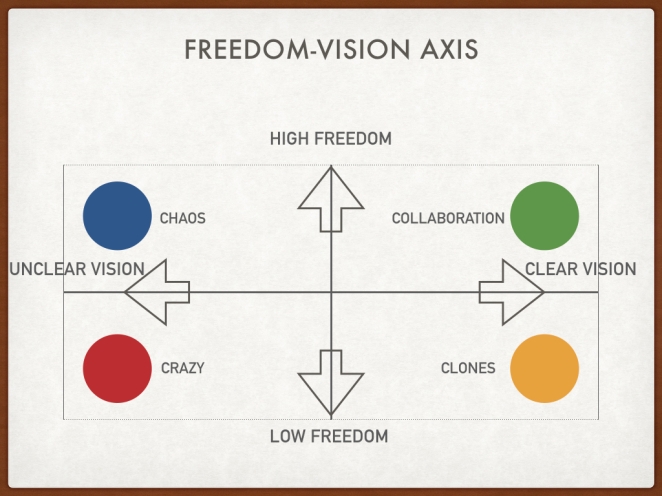As leaders who care about the people we lead, we tend to vacillate between being empowering of our team and being directive with them. These two things are not mutually exclusive, of course, but we sometimes view the two approaches as being on either end of a spectrum. Should I tell the team what I want them to do or should I let them create on their own?
What can be especially confusing in any organization is when we adopt one approach on some days, and the other approach on other days. People may wonder which leader they’re going to get—the one who says, ‘Go for it!’ or the one who says, ‘Not so fast!’
Taking my cues from Stephen Covey, Andy Crouch and others, I believe that many of the concepts that we often lay on as opposites on a single line can be re-plotted on a 2×2 graph that shows what happens when both co-exist.
1. Unclear Vision-Low Freedom
Beginning with the bottom left, when a leader has a low or unclear vision and gives low freedom, the organizational culture is crazy. As in, it’s a madhouse. No one knows what’s going on, or why we’re doing anything, and worse yet, no one can speak up or change things. I doubt many of us could survive for very long in an environment like that.
2. Unclear Vision-High Freedom
Then, in the top left, when a leader has low or unclear vision but provides high freedom to the team, it is chaos. This is like how the writer in the biblical book of Judges describes Israel: ‘Everyone did what was right in his own eyes.’ In an organization like like this, silos develop, people jostle for power and control, no one really knows who is in charge. People are unclear of the ‘why’ for any of their actions, so they only do the things they like or enjoy or believe in. There is freedom, but no vision.
3. Clear Vision-Low Freedom
Over in the bottom right is a depiction of what results when a leader gives plenty of vision but provides little to no freedom: clones. When a leader functions like this, he or she will stop attracting innovative thinkers and creative leaders. They will only have good foot soldiers. Now, don’t get me wrong: Every organization needs loyal people who are happy to execute the task. But organizations that renew themselves require a team of leaders who are not afraid to dream out loud, challenge the status quo and re-imagine the future. Yet all this must be done within the organization’s culture and values. In short, there must be both freedom and vision.
4. Clear Vision-High Freedom
Which leads us to the box on the top right. When a leader provides a clear and compelling vision and a high degree of freedom, collaboration results. Strong leaders stop competing with one another because they understand their shared goal. Creative thinkers aren’t sidelined or bored because they are tasked not with simply executing a plan, but with imagining better ways to achieve their shared goal.
Applying this…
I think that there are different ways for leaders to provide clear vision and high freedom, ways that fit the leader’s strengths and personalities. (For example, think of the difference between a quarterback and a point guard. Both may call plays, but the amount of improvisation from the team differs.) Furthermore, each team member may differ in the amount of freedom or vision they need. Some people freeze with indecision when they are given the same of freedom that another person requires; other people may wilt under the amount of vision that another person loves.
I am grateful to work in a place where both freedom and vision are cherished. Though we don’t have it all figured out, a collaborative culture is something we strive to create and to steward at New Life. So, in my ongoing quest to grow as a leader, I am making it a goal to listen to my team better in order to make sure they feel they have the right combination and freedom and vision to thrive and collaborate.


